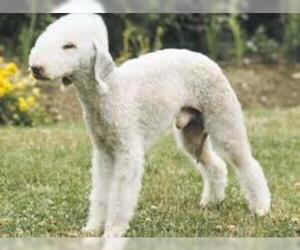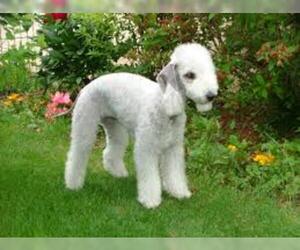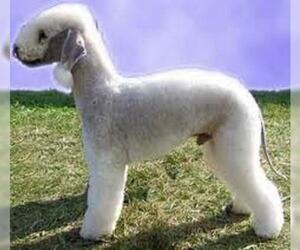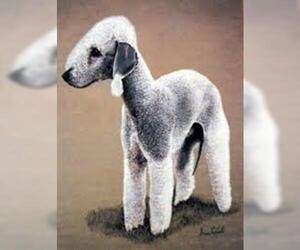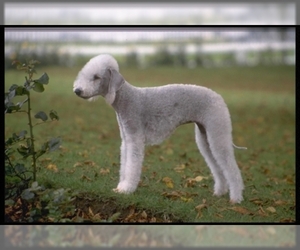
All about Bedlington Terrier dog breed
A.K.A. :Rothbury Terrier, Rothbury's Lamb, Gypsy Dog, Lamb of the Fells
Size
Grooming requirements
Exercise requirements
Good with other dogs
Watchdog ability
Energetic
Training requirements
Playful
Affectionate
Good with other pets
Good with children
Good with strangers
Winter
Summer
Healthiness
Protective
Life Span
| Pure Breeds | Member |
| Breeds A - Z | B |
| Breeds by Group | Terrier |
| Breeds by Trait | Hypoallergenic Low Shedding |
| Overview: | The Bedlington Terrier is a distinctive breed originating from the mining towns of Northumberland, England, primarily used for hunting vermin. Physically, they are often described as resembling a lamb, with a unique arched back, pear-shaped head, and a woolly, non-shedding blue, liver, or sandy coat that requires regular grooming. Despite their gentle appearance, Bedlingtons possess a terrier's feisty spirit, being intelligent, affectionate, and surprisingly athletic. They are generally good with children and other pets when properly socialized, making them suitable for active families. Their moderate size and relatively low exercise needs (beyond daily walks and playtime) mean they can adapt well to apartment living, provided they receive sufficient mental and physical stimulation. While generally robust, some health considerations include copper toxicosis (an inherited liver disease) and eye conditions like retinal dysplasia, making responsible breeding and regular veterinary check-ups important. |
F.A.Q.
All You Need to Know About the Bedlington Terrier Breed
The Bedlington Terrier is a unique and captivating breed, originally hailing from the English town of Bedlington, Northumberland. Known for their distinctive lamb-like appearance, these elegant dogs possess a surprising amount of terrier spirit. Their temperament is generally described as affectionate and gentle with family, yet courageous and energetic outdoors. Physically, they boast a curly, linty coat (often blue, liver, or sandy), an arched back, and a pear-shaped head. They are well-suited for families who can provide consistent training and socialization, and their moderate size makes them adaptable to apartment living, provided their exercise needs are met. Regular grooming, including professional clipping every 6-8 weeks, is essential to maintain their unique coat. Daily walks and playtime are usually sufficient for their exercise requirements. Common health considerations for the Bedlington Terrier include copper toxicosis and patellar luxation, making responsible breeding and regular vet check-ups important for this charming companion.Bedlington Terrier Weight: Average Size & Healthy Weight for Bedlington TerrierThe average weight of a Bedlington Terrier is approximately 18-23 pounds.Typically, adult male Bedlington Terriers tend to weigh between 18-23 pounds, while adult female Bedlington Terriers generally fall within the 17-22 pound range. This provides a good guide for the healthy weight for Bedlington Terrier.
What is the average height of a Bedlington Terrier?
Curious about the typical Bedlington Terrier height? These elegant and distinctive terriers are generally a medium-small breed, known for their unique lamb-like appearance. The average size of an adult Bedlington Terrier, measured at the shoulder (withers), typically falls within a range of 15 to 17.5 inches.While this range provides a good guideline for how tall is a Bedlington Terrier, there can be slight variations. Generally, male Bedlington Terriers might be at the upper end of this range or slightly taller, while females might be at the lower end or a bit shorter. However, individual genetics play a significant role, so you might find some dogs outside these exact measurements, whether a bit smaller or larger than the average. When considering a Bedlington Terrier, always look at the overall proportion and health of the dog.The Bedlington Terrier typically comes in a range of AKC recognized Bedlington Terrier colors including blue, liver, and sandy, all of which may or may not have tan points. You'll also find blue and tan, liver and tan, and sandy and tan. These are the standard and most commonly seen Bedlington Terrier colors, widely accepted by major kennel clubs. While there aren't officially recognized "rare" or "exotic" variations in the same way some breeds have extensive pattern genes, breeders may occasionally use terms to describe lighter or darker shades within these categories. However, merle, chocolate, brindle, cream, or white are not standard or accepted Bedlington Terrier colors by the AKC and would indicate a non-purebred lineage. Potential adopters or buyers should focus on the blue, liver, and sandy variations, with or without tan, when seeking an AKC-compliant Bedlington Terrier.
The Bedlington Terrier personality is a unique blend of gentle charm and spirited courage. Known for their lamb-like appearance, their temperament of Bedlington Terrier is generally affectionate, loyal, and playful with their families. They are highly intelligent and can be quite entertaining. Bedlingtons are friendly and sociable when well-socialized, enjoying the company of their human companions. They adapt well to various living situations, including apartment living, provided they receive adequate exercise and mental stimulation. They can be good with respectful children, often forming strong bonds. However, like many terriers, they possess a strong prey drive and may not be suitable for homes with small, non-canine pets unless introduced and supervised carefully from a young age. Early socialization and consistent training are key to bringing out the best in this delightful breed.
Bedlington Terrier Temperament & PersonalityThe Bedlington Terrier boasts a unique and captivating temperament, making them an excellent companion for the right family. Known for their striking lamb-like appearance, their personality is equally distinctive.Key Traits:* Friendly & Sociable: Bedlingtons are generally very friendly and outgoing, often greeting strangers with a wagging tail. They thrive on human interaction and form strong bonds with their families. Their sociable nature makes them a delightful presence in the home.* Loyal & Affectionate: This breed is incredibly loyal and devoted to their owners, often shadowing them from room to room. They are affectionate and enjoy cuddling, making them wonderful lap dogs.* Intelligent & Adaptable: Bedlingtons are intelligent dogs, capable of learning quickly. While they have a natural athleticism, their moderate exercise needs and relatively compact size make them surprisingly adaptable to apartment living, provided they receive daily walks and mental stimulation.* Good with Children (with caveats): With proper socialization and respectful children, Bedlingtons can be good family pets. However, like most terriers, they have a prey drive and can be sensitive to rough handling. Supervision is always recommended with young children.* Behavior with Other Pets: Due to their terrier heritage, they can have a strong prey drive towards smaller animals like cats or rodents if not raised with them. Early and consistent socialization is crucial for peaceful cohabitation with other pets. They generally get along well with other dogs, especially when introduced properly.* Stubbornness & Sensitivity: While intelligent, Bedlingtons can exhibit a streak of stubbornness, a common terrier trait. Consistent, positive reinforcement training is most effective. They are also relatively sensitive dogs and do not respond well to harsh corrections or yelling. A gentle yet firm approach is best.The Bedlington Terrier is a lively, loving, and engaging companion dog that brings much joy to its owners. Their unique blend of charm, intelligence, and loyalty makes them a truly special breed.
Bedlington Terrier Care: Daily Maintenance & Health TipsCaring for a Bedlington Terrier is rewarding, requiring attention to their unique needs. Grooming needs are significant; their distinctive lamb-like coat is low-shedding but needs regular attention. Professional grooming every 6-8 weeks is essential to maintain the coat's texture and prevent matting. Daily to weekly brushing at home is recommended to keep it tangle-free.Exercise limitations are moderate. Despite their athletic appearance, Bedlington Terriers are not high-energy dogs. They thrive on daily walks, playtime in a secure yard, and mental stimulation. They adapt well to apartment living if their exercise needs are met.Dietary considerations are crucial for maintaining a healthy weight and coat. Feed a high-quality dog food appropriate for their age, size, and activity level. Monitor portion sizes to prevent obesity, a common issue in many breeds.Wrinkle and ear cleaning are vital. While Bedlingtons aren't truly brachycephalic, they do have deep ear canals and some facial folds that require regular cleaning to prevent infections. Check and clean ears weekly, and wipe any facial wrinkles as needed with a damp cloth.Climate sensitivity is not a major concern due to their single coat, but like all dogs, they should not be left in extreme heat or cold. Their athletic build helps them regulate temperature well.Common health concerns include skin issues, which can sometimes arise from allergies or improper grooming. Regular brushing and a balanced diet can help. Dental care is paramount; daily brushing or dental chews are recommended to prevent periodontal disease. Weight management is key to preventing joint problems and other health complications. Regular vet check-ups are essential for early detection of any health issues, including eye problems like Progressive Retinal Atrophy (PRA), which can affect the breed. For a low-energy dog breed with unique charm, how to care for a Bedlington Terrier involves consistent grooming, moderate exercise, and attentive health monitoring.
The Bedlington Terrier activity level is moderate. They are not as hyper as some other terriers, balancing short bursts of high-energy play with long periods of rest. How active are Bedlington Terriers? They enjoy daily walks, about 30-60 minutes, and opportunities for off-leash play in a secure area. Their natural athleticism means they excel in activities like fetch, agility, and lure coursing.Despite their energetic bursts, Bedlingtons are generally calm indoors and known for being excellent "off switches" – happy to relax on the couch after their exercise needs are met. However, it's crucial to note that Bedlington Terriers are brachycephalic, meaning they have a shortened muzzle. This makes them susceptible to overheating, especially in warm weather or during strenuous exercise. Always monitor them for signs of heat distress and ensure they have access to water and shade. Their playtime preferences include chasing, digging (a typical terrier trait), and interactive games with their owners.They are suitable for both active families who can provide consistent exercise and for low-energy households, provided their daily walk and playtime are non-negotiable. Their ability to balance energy with calmness makes them adaptable to various lifestyles, as long as their moderate Bedlington Terrier exercise needs are consistently met.
Breed Breakdown: What Experts Say About the Bedlington Terrier
Rating: 3The Bedlington Terrier, with its average height of 15-17 inches and weight of 17-23 pounds, is a distinctly small to medium-sized dog. Its unique, lean, and athletic body structure, often described as resembling a lamb, contributes to its overall compact appearance. Compared to many other companion breeds, the Bedlington is notably on the smaller end of the spectrum, making it an excellent candidate for apartment living, frequent travel, or households with limited space. Their modest physical dimensions ensure they don't require vast amounts of room to be comfortable and happy.
I would rate the Bedlington Terrier's "Grooming Requirements" at a 7.While they are often lauded as a low-shedding breed, which is a major plus for allergy sufferers, their unique lamb-like coat is far from low-maintenance. This soft, woolly, and non-shedding coat tends to mat and felt if not brushed regularly and thoroughly, requiring professional or skilled home grooming every 4-6 weeks to maintain its characteristic appearance and prevent severe matting. This involves not just a bath and dry, but also clipping and scissoring. Their ears need regular checking and cleaning to prevent wax buildup and infections, and like all dogs, their nails need routine trimming. They aren't particularly prone to skin fold issues, but their tight curls around the eyes can sometimes trap debris. Compared to many other companion dogs, the Bedlington Terrier requires frequent, specialized grooming beyond basic brushing, making them a higher-maintenance breed in this regard, despite their low shedding.
I'd rate the Bedlington Terrier's "Exercise Requirements" a 6 out of 10.While not a hyperactive breed that demands constant running, the Bedlington Terrier is far from a couch potato. They possess a surprising amount of stamina and athleticism for their size, a legacy of their terrier and sighthound heritage. Daily activity recommendations usually involve at least an hour of moderate exercise, which can be broken into several sessions. They thrive on brisk walks, with opportunities to trot and explore, and enjoy energetic playtime in a secure yard. Their agility and speed make them excellent candidates for earthdog trials, lure coursing (in a modified capacity due to their shorter legs compared to pure sighthounds), and even some agility, though they may not be as naturally gifted as a Border Collie. They have good tolerance for sustained movement once warmed up, but they aren't built for endurance running alongside a cyclist for miles. Importantly, they are not brachycephalic, so they don't have the respiratory limitations of breeds like Bulldogs, allowing them to exert themselves without undue risk. To stay healthy and mentally stimulated, they definitely require structured routines that involve more than just a potter around the block. Without sufficient exercise, they can become bored, leading to undesirable behaviors like digging or excessive barking. They benefit greatly from opportunities to run, chase, and engage their intelligent minds, preventing them from becoming restless or destructive.
I'd rate the Bedlington Terrier's "Watchdog Ability" at a 6.While not a true guard dog, the Bedlington Terrier possesses a surprising level of alertness and a clear territorial instinct that makes them more than a passive companion. They are quick to notice anything out of the ordinary, whether it's an unfamiliar sound outside or someone approaching the door. This often translates into a sharp, sometimes insistent bark, which serves as an effective early warning system. They aren't typically aggressive, and their deterrent factor is more in their vocalizations and immediate awareness rather than a physical challenge. They are certainly capable of providing meaningful early warnings in a home environment, letting their owners know that something is amiss, but they are unlikely to escalate beyond that into a true protective stance against an intruder.
I would rate the "Good with Other Dogs" trait of the Bedlington Terrier as a 6.Bedlington Terriers are a unique breed with a fascinating blend of characteristics that influence their interactions with other dogs. On the one hand, they are generally affectionate and can form strong bonds within their family, including other canine members. When properly socialized from a young age, they can certainly thrive in a multi-dog household and enjoy the companionship of their fellow canines. They are often playful and can adapt to different energy levels, sometimes engaging in spirited play with active dogs and other times being content to lounge with more mellow companions.However, the Bedlington Terrier's terrier heritage cannot be overlooked. They possess a strong prey drive and a certain feisty independence that, without careful management, can manifest as dominant or reactive behavior towards unfamiliar dogs. While not inherently aggressive, their confidence and sometimes sensitive nature can lead to defensive responses if they feel challenged or threatened. They may require careful, supervised introductions to new dogs, especially those of similar size or perceived assertiveness. Their adaptability to different sizes and energy levels depends heavily on their individual temperament and the quality of their early socialization. They don't always naturally default to extreme sociability and can be prone to "picking" their friends. Therefore, while they can absolutely coexist peacefully and even joyfully with other dogs, it often requires consistent training, ongoing positive reinforcement, and a watchful eye from their owner to ensure harmonious interactions. They typically require careful introductions and training to coexist peacefully, rather than naturally being extremely sociable from the outset.
I'd rate the Bedlington Terrier's "Energetic" trait a 7 out of 10.While not in the hyperactive category of some terriers, Bedlingtons are far from couch potatoes. They possess a surprising amount of stamina and a playful spirit. They are naturally active dogs that thrive on regular exercise, enjoying walks, runs, and engaging in games. Their terrier heritage means they have a decent prey drive and a zest for exploration, making them good candidates for agility or other dog sports if properly trained. They do require consistent physical stimulation to prevent boredom and destructive behaviors. However, it's crucial to remember that Bedlington Terriers are *not* brachycephalic; they possess a distinctive, elegant head with a long, tapering muzzle, which contributes to excellent respiratory function and stamina. This allows them to maintain a good exercise tolerance without the breathing difficulties that short-nosed breeds might encounter, enabling them to participate robustly in various outdoor and athletic activities. They are more active than many companion dogs but aren't typically "bouncing off the walls" if their exercise needs are met.
I would rate the Bedlington Terrier's "Training Requirements" at a 7 out of 10.While intelligent and capable of learning, the Bedlington Terrier possesses a significant degree of independent thought and a classic terrier stubbornness. Their attention span can be fleeting, especially if they catch a scent or spot something interesting, making consistent focus during training sessions a challenge. They are not naturally eager to please in the way some other breeds are, and their responsiveness to commands often depends on their assessment of whether it's worth their effort. Positive reinforcement is highly effective, but it needs to be delivered with enthusiasm and variety to keep them engaged. Consistency is paramount; any slack in training can quickly lead to them taking advantage and reverting to their own agenda. This breed is generally not considered beginner-friendly for training. They thrive with experienced handling, structured routines, and owners who are patient, firm, and creative in making training fun and rewarding. Without these, they can become a handful, demonstrating selective hearing and pursuing their own, often mischievous, desires.
The Bedlington Terrier typically rates around a 7 out of 10 for the "Playful" trait.While not as relentlessly hyper as some other terrier breeds, Bedlington Terriers are far from inactive. They possess a delightful and often comical playfulness that is a hallmark of their character. They absolutely adore games and interaction, particularly with their family. Their typical activity level is moderate to high; they thrive on walks, runs, and engaging playtime. Bedlingtons are generally enthusiastic in daily life, greeting their loved ones with wags and often a playful "woo-woo" sound. They respond very well to toys, especially those that allow for a good chase or a game of tug, and their attention-seeking behavior is usually expressed through nudges, pawing, or bringing toys to initiate play. They can be incredibly silly and enjoy being the center of attention during play sessions. Compared to more laid-back companion dogs like a Basset Hound, the Bedlington is naturally quite spirited, but they are also capable of settling down for a cuddle after a good romp, unlike some breeds that maintain an almost constant state of high energy. They are playful, but with a degree of grace and wit that makes their antics charming rather than overwhelming.
Rating: 8The Bedlington Terrier, despite its sometimes aloof appearance, is a surprisingly affectionate and people-oriented breed. They possess a strong desire for human companionship and are known for their loyalty to their families. While not always the most overt "cuddlers" in terms of constant lap-sitting, they definitely appreciate physical closeness and will readily lean against you or seek proximity. They are sensitive to their owner's emotions, often picking up on moods and offering comfort in their own way. Bedlingtons also have a notable tendency to follow their family members around the house, acting as quiet shadows, which is a clear indication of their desire to be involved and close. This breed absolutely thrives on affection and close bonds, often becoming deeply attached to their owners, though they maintain a certain playful independence that prevents them from being utterly clingy.
I would rate the "Good with Other Pets" trait of the Bedlington Terrier as a 6.Bedlington Terriers generally fall in the middle when it comes to coexisting with other pets. Their inherent terrier nature gives them a moderately high prey drive, particularly towards smaller, fast-moving animals like cats and rodents. This means that while some Bedlingtons can live peacefully with cats, especially if introduced early and raised together, others may see a cat as something to be chased. They are not naturally as universally accepting of felines as some other breeds and will likely require significant early socialization, consistent training, and careful supervision to ensure a peaceful multi-cat household.When it comes to other dogs, Bedlingtons are generally more sociable. They tend to enjoy the company of other canines, especially if well-socialized from a young age. However, like many terrier breeds, they can sometimes exhibit typical "terrier spunk" and may not back down from a challenge if provoked, particularly with dogs of the same sex. Resource guarding can occur, as with any breed, but it's not a uniquely prominent trait for Bedlingtons; proper training and management are key. With consistent socialization and responsible ownership, they can be a great addition to a multi-dog household. Their adaptability is good, but their natural instincts, particularly the prey drive, mean that achieving extreme pet-friendliness (a 10) requires more intentional effort, training, and supervision compared to breeds with a naturally lower prey drive. They are not naturally *extremely* pet-friendly, but they are far from highly incompatible.
I would rate the Bedlington Terrier's "Good with Children" trait a 7 out of 10.While not inherently the *most* bomb-proof, exceptionally child-friendly breed, the Bedlington Terrier can be a wonderful family companion. Their temperament is generally described as gentle, affectionate, and playful. They possess a good degree of patience and are known to be quite tolerant of the noise and activity that often accompany children. Their playful nature makes them willing participants in games, and they often form strong bonds with the children in their family.However, it's important to note that Bedlingtons, like all terriers, have a spirited side. While generally good-natured, their sensitivity and sometimes independent streak mean they thrive best in homes where children are taught to interact respectfully with them. They are not typically prone to aggression, but their patience can be tested by overly boisterous or rough handling, especially if not properly socialized from a young age. Therefore, some supervision is always advisable with very young children, and consistent training in good manners for both the dog and the children will help them thrive in a family setting. They are naturally gentle and affectionate but benefit immensely from early socialization and consistent, positive reinforcement training to ensure their best behavior around kids.
The Bedlington Terrier typically rates a 7 for "Good with Strangers."While naturally charming and often quite affectionate with their own families, Bedlington Terriers are not usually the type to greet every new person with boisterous enthusiasm. They possess a degree of terrier independence and can be a bit reserved or discerning with unfamiliar adults. They aren't inherently unfriendly, but rather tend to be observant and may take a little time to warm up. Their "lamb-like" appearance can be deceiving; beneath it lies a courageous and alert terrier. While not prone to excessive barking or aggressive guarding of people, they will certainly alert you to a stranger's presence. With proper early socialization, they can become quite amiable and adaptable in public or guest-filled environments, enjoying the attention once they've deemed a person acceptable. However, they are not naturally outgoing to the extent of, say, a Golden Retriever, and require consistent, positive exposure to new people and situations from a young age to ensure they are comfortable and welcoming rather than just tolerant. Without good socialization, they can lean towards being more aloof.
I would rate the Bedlington Terrier's "Winter" tolerance at a 4.While they possess a dense, woolly double coat, it's not particularly long or heavily insulating. Their lean build means they have very little body fat to act as a thermal layer, and their moderate size makes them more susceptible to heat loss than larger breeds. They are not brachycephalic, so breathing in cold air isn't a primary concern, but their low body fat and relatively thin skin put them at a higher risk of hypothermia in prolonged cold exposure. They can enjoy short bursts of outdoor activity in moderately cold temperatures, but extended periods or extremely low temperatures are not suitable for them. Compared to many other companion dogs, Bedlington Terriers absolutely require special care during winter months. They will benefit greatly from a warm dog coat or sweater for walks, and their outdoor time should be carefully monitored to prevent shivering or discomfort. They are not a breed suited for being left outside in cold weather and are much more comfortable in a warm indoor environment.
The Bedlington Terrier would rate a 6 for summer tolerance. While not brachycephalic, which is a significant advantage in heat compared to breeds like Pugs or Bulldogs, their dense, woolly coat, even when clipped, can trap heat. They are generally active dogs, and their ability to regulate body temperature is average for a canine; they pant to cool down. They do have a moderate risk of heatstroke, especially during vigorous exercise or extended sun exposure, though it's less pronounced than in brachycephalic breeds. Recommended outdoor activity levels should be carefully monitored during hot weather, with strenuous activity limited to cooler parts of the day. They certainly require more special care in summer months than a smooth-coated, less active dog, and would benefit from access to shade, water, and air conditioning on very hot days, making them more sensitive than a truly heat-tolerant breed but far less so than those with respiratory compromises.
I would rate the Bedlington Terrier's "Healthiness" trait as a 7 out of 10.While generally a robust and energetic breed, the Bedlington Terrier isn't without its specific health concerns, preventing a higher score. The most significant genetic predisposition is Copper Toxicosis, a serious and potentially fatal liver disease. Responsible breeding involves genetic testing for this condition, which has greatly reduced its prevalence. Other breed-specific issues, while less common or severe than in some other breeds, include eye problems like progressive retinal atrophy and distichiasis, as well as some joint conditions like patellar luxation. Their life expectancy is respectable, typically ranging from 12 to 14 years.Compared to many other companion dogs, the Bedlington Terrier is generally considered more robust than high-maintenance. They don't typically suffer from the widespread structural problems or breathing difficulties seen in brachycephalic breeds, nor are they as prone to the extensive joint issues or allergies found in some larger breeds. However, the potential for Copper Toxicosis means that vigilance and an understanding of the breed's specific needs are crucial for owners, and regular veterinary check-ups are always important. When bred responsibly and given proper care, they are generally healthy and active companions.
I would rate the Bedlington Terrier's "Protective" trait at a 7 out of 10.While not a true guard dog in the aggressive sense, the Bedlington Terrier possesses a surprising level of protective instinct for its size. Their terrier heritage imbues them with excellent alertness; they are quick to notice and react to anything out of the ordinary in their environment, making them fantastic watchdogs. They have a strong territorial instinct within their home and will loudly announce the arrival of strangers or perceived threats with their characteristic bark. Their loyalty to their owners is unwavering, and they will instinctively place themselves between their family and perceived danger.However, their protective nature leans more towards warning and deterrence rather than outright physical confrontation. While they may stand their ground and show a surprising amount of bravado, they are ultimately companion dogs, not bred for a "guard dog" role where they would be expected to actively engage and incapacitate a threat. Their "protection" comes primarily from their vigilant barking and their willingness to alert their owners to potential problems, and in some cases, intimidate with their spirited demeanor. They are capable of offering meaningful *warning* and *deterrence* in a household setting, making them good at notifying you of an intruder, but they shouldn't be relied upon for serious physical protection.
I would rate the Bedlington Terrier's "Life Span" trait a 9 out of 10.Bedlington Terriers are considered a long-lived breed, with an average life expectancy typically ranging from 12 to 16 years, and it's not uncommon for them to live even longer. This puts them well above the average lifespan for most companion dogs. While they do have some genetic predispositions, such as copper toxicosis (which responsible breeders actively screen for), and a lesser risk of some eye conditions, these are often manageable or avoidable with good breeding practices and veterinary care. Their relatively robust health and lower incidence of many common large-breed ailments contribute significantly to their impressive longevity.
Bedlington Terrier Dogs for adoptionSee all dogs for adoption
Bedlington Terrier BreedersSee all breeders
Similar Dog Breeds for Bedlington Terrier
Breed Mixes of Bedlington Terrier
Quick Breed Selector 0 - not important, 1 - smallest, 10 - largest
Variants & Mistakes :Bedlington Terrior, Bedington Terrier, Bedlington Teria, Bedlington Terryer, Bedlinton Terrier, Bellington Terrier, Bedlinton Terrior, Bedlington Tarrier, Bedlington Terier, Bedington Terrior, Bedlingtion Terrier, Biddlington Terrier, Bedlington Terree, Bedlington Terrea, Bedlingten Terrier, Bedlington Terreir, Biedlington Terrier, Bedlinton Teria, Bedlington Terriar, Bedlington Terrir, Bedlington Terrierr, Bedlington Terrere, Bedlington Terreri, Bedington Terria, Bedlington Terir, Bedlington Tereir, Bedlington Tere, Bedlington Terri, Bedlington Terry, Bedlinton Terryer, Bedlington Tarier, Bedlington Taria, Bedlington Tarie, Bedlington Terie, Bedlington Teri, Bedlington Tear, Bedlington Teer, Bedlington Tirer, Bedlingtone Terrier, Bedlington Terria, Bedlinton Terier, Bedlington Terere, Bedlington Tererei, Bedlington Terriyere
